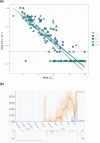Viral infectivity in paediatric SARS-CoV-2 clinical samples does not vary by age
- PMID: 37323941
- PMCID: PMC10267661
- DOI: 10.1099/acmi.0.000547.v4
Viral infectivity in paediatric SARS-CoV-2 clinical samples does not vary by age
Abstract
At the start of the severe acute respiratory syndrome coronavirus 2 (SARS-CoV-2) pandemic, there was much uncertainty about the role of children in infection and transmission dynamics. Through the course of the pandemic, it became clear that children were susceptible to SARS-CoV-2 infection, although they were experiencing a notable lack of severe disease outcomes as compared to the adult population. This trend held true with the emergence of new SARS-CoV-2 variants, even in paediatric populations that were ineligible to be vaccinated. The difference in disease outcomes has prompted questions about the virological features of SARS-CoV-2 infection in this population. In order to determine if there was any difference in the infectivity of the virus produced by children with coronavirus disease 2019 (COVID-19), we compared viral RNA levels (clinical RT-qPCR C T) and infectious virus titres from 144 SARS-CoV-2-positive clinical samples collected from children aged 0 to 18 years old. We found that age had no impact on the infectiousness of SARS-CoV-2 within our cohort, with children of all ages able to produce high levels of infectious virus.
Keywords: SARS-CoV-2; clinical isolates; paediatric; viral infectivity.
© 2023 The Authors.
Conflict of interest statement
The authors declare that there are no conflicts of interest.
Figures

Update of
-
Viral infectivity in pediatric SARS-CoV-2 clinical samples does not vary by age.medRxiv [Preprint]. 2022 Oct 18:2022.10.17.22281193. doi: 10.1101/2022.10.17.22281193. medRxiv. 2022. Update in: Access Microbiol. 2023 May 26;5(5):acmi000547.v4. doi: 10.1099/acmi.0.000547.v4. PMID: 36299435 Free PMC article. Updated. Preprint.
Similar articles
-
Viral infectivity in pediatric SARS-CoV-2 clinical samples does not vary by age.medRxiv [Preprint]. 2022 Oct 18:2022.10.17.22281193. doi: 10.1101/2022.10.17.22281193. medRxiv. 2022. Update in: Access Microbiol. 2023 May 26;5(5):acmi000547.v4. doi: 10.1099/acmi.0.000547.v4. PMID: 36299435 Free PMC article. Updated. Preprint.
-
Determining the impact of vaccination on SARS-CoV-2 RT-PCR cycle threshold values and infectious viral titres.Access Microbiol. 2023 Oct 20;5(10):000597.v3. doi: 10.1099/acmi.0.000597.v3. eCollection 2023. Access Microbiol. 2023. PMID: 37970082 Free PMC article.
-
[Evaluation of the dynamics of detection of viable SARS-CoV-2 (Coronaviridae: Betacoronavirus: Sarbecovirus) in biological samples obtained from patients with COVID-19 in a health care setting, as one of the indicators of the infectivity of the virus].Vopr Virusol. 2023 May 18;68(2):105-116. doi: 10.36233/0507-4088-160. Vopr Virusol. 2023. PMID: 37264845 Russian.
-
Human and novel coronavirus infections in children: a review.Paediatr Int Child Health. 2021 Feb;41(1):36-55. doi: 10.1080/20469047.2020.1781356. Epub 2020 Jun 25. Paediatr Int Child Health. 2021. PMID: 32584199 Review.
-
Notable and Emerging Variants of SARS-CoV-2 Virus: A Quick Glance.Indian J Clin Biochem. 2021 Oct;36(4):451-458. doi: 10.1007/s12291-021-00991-0. Epub 2021 Jun 28. Indian J Clin Biochem. 2021. PMID: 34219999 Free PMC article. Review.
References
Grants and funding
LinkOut - more resources
Full Text Sources
Miscellaneous
